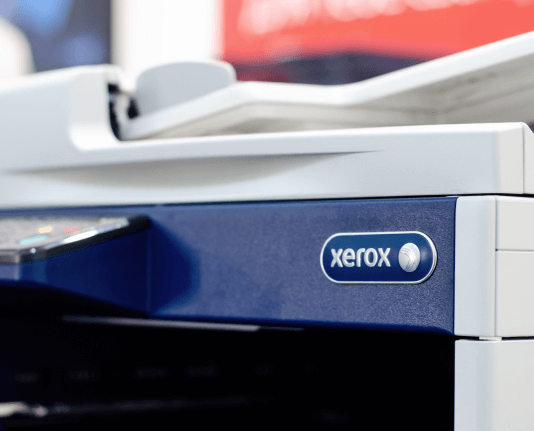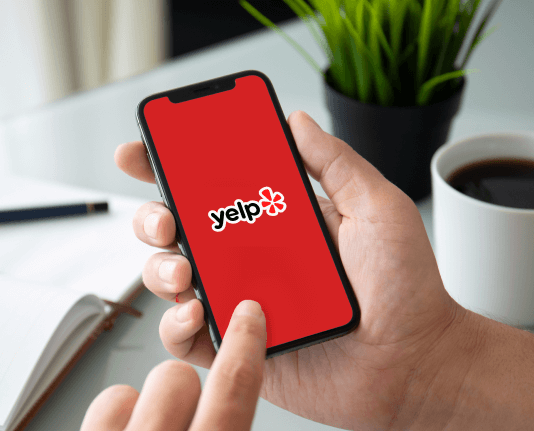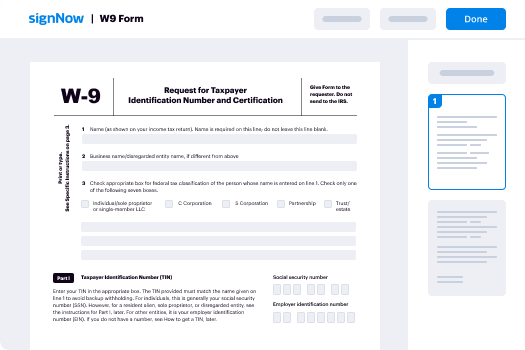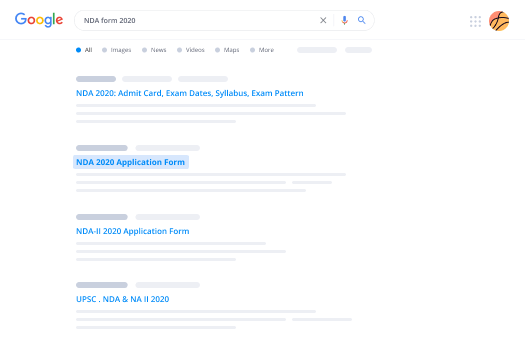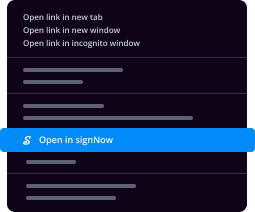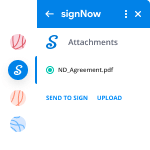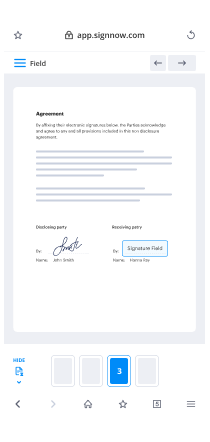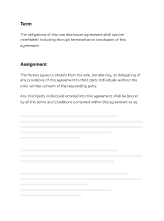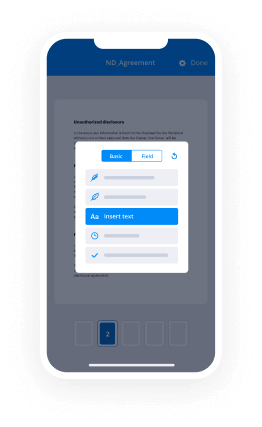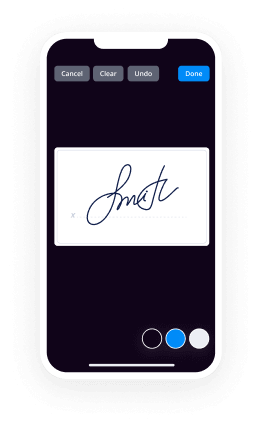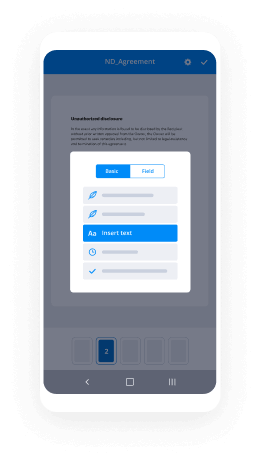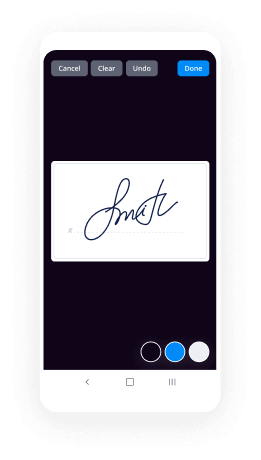How To Set Up Sign in DropBox
Contact Sales
Make the most out of your eSignature workflows with airSlate SignNow
Extensive suite of eSignature tools
Robust integration and API capabilities
Advanced security and compliance
Various collaboration tools
Enjoyable and stress-free signing experience
Extensive support
Keep your eSignature workflows on track
Our user reviews speak for themselves






How to finish a Dropbox registration with airSlate SignNow
Are you seeking to optimize your document signing workflow? With airSlate SignNow, you can effortlessly handle your documents while employing a Dropbox registration to guarantee a smooth process. This platform offers companies an intuitive, affordable solution for sending and digitally signing documents, establishing it as a vital resource for small and medium-sized businesses.
Instructions for Dropbox registration with airSlate SignNow
- Launch your web browser and go to the airSlate SignNow website.
- Select to either register for a free trial or log in if you already possess an account.
- Upload the document you want to have signed or dispatch it for signatures.
- If you wish to utilize this document later, convert it into a template for quick access.
- Open the uploaded file to make essential modifications, such as adding fillable fields or inserting required data.
- Sign your document and add signature fields for each recipient.
- Click 'Continue' to complete the setup and send out an electronic signature invitation.
In summary, airSlate SignNow provides a powerful array of features that yield signNow ROI, ensuring you maximize your investment. Its user-friendliness and scalability render it ideal for small to mid-sized enterprises, while transparent pricing keeps your budget secure.
Ready to improve your document management workflow? Begin your Dropbox registration with airSlate SignNow today and enjoy exceptional support, free of hidden charges!
How it works
Rate your experience
-
Best ROI. Our customers achieve an average 7x ROI within the first six months.
-
Scales with your use cases. From SMBs to mid-market, airSlate SignNow delivers results for businesses of all sizes.
-
Intuitive UI and API. Sign and send documents from your apps in minutes.
A smarter way to work: —how to industry sign banking integrate
FAQs
-
What is the process for Dropbox signup with airSlate SignNow?
To complete a Dropbox signup with airSlate SignNow, simply navigate to the SignNow website and select the option to integrate with Dropbox. You will be prompted to log in to your Dropbox account, granting permission for SignNow to access your files. Once linked, you can easily send and eSign documents stored in your Dropbox account.
-
Are there any costs associated with Dropbox signup for airSlate SignNow?
The Dropbox signup for airSlate SignNow is free, but you may need a subscription to access advanced features of the eSignature platform. SignNow offers various pricing plans, allowing you to choose one that fits your needs. Additionally, you can start with a free trial to explore the full capabilities before committing.
-
What features are available after Dropbox signup with airSlate SignNow?
After completing the Dropbox signup with airSlate SignNow, you gain access to a range of features including document templates, real-time tracking, and secure eSignatures. You can also collaborate with team members, send reminders, and automate workflows directly from your Dropbox files. This enhances productivity and ensures a seamless signing process.
-
How does Dropbox integration benefit airSlate SignNow users?
Integrating Dropbox with airSlate SignNow enhances user experience by allowing direct access to files stored in Dropbox. This means you can quickly send documents for eSignature without the hassle of downloading and uploading files separately. The integration streamlines your workflow, saving time and effort in document management.
-
Can I use airSlate SignNow without signing up for Dropbox?
Yes, you can use airSlate SignNow without a Dropbox signup. While Dropbox integration adds convenience, SignNow is designed to work independently, allowing users to upload documents from various sources. You can still enjoy all the essential features of eSigning without needing a Dropbox account.
-
What types of documents can I sign after Dropbox signup?
After completing your Dropbox signup with airSlate SignNow, you can sign various document types, including contracts, agreements, and forms. The platform supports multiple file formats such as PDF, Word, and image files, ensuring flexibility for all your document signing needs. This versatility helps streamline your business operations.
-
Is airSlate SignNow secure after Dropbox signup?
Absolutely, airSlate SignNow prioritizes security after your Dropbox signup. The platform employs industry-standard encryption and complies with regulations like GDPR and eIDAS to protect your sensitive information. You can confidently send and sign documents knowing that your data is secure.
-
What are some examples and best practices for effective welcome emails?
There are lots of ways you can approach this, but there are a few key things I would suggest you hit on. One important thing is to acknowledge their effort to sign up and thank them in a timely manner. This email should go out right away, not a day later.Next, it is important to remember that you are setting the stage for how they view your brand - - as this will be the first email they get from you and the first part of what will hopefully be an ongoing conversation with them. How do you want your brand positioned and what is the tone it should speak in? This is your chance to let the user know and the welcome email should speak in this manner to set or re-enforce your brand and it's promise. It's design should be simple and clean, but again reflect your brand and the feel of your website which they just interacted with.After that focus on what value you can provide to them with this email. What will they need to know for their next steps? Keep it simple and to the point. "Thanks for joining, now that you're in here's the first things you will want to do. Also here is where you can get help if you have questions. Tips to optimize the use of your service is also good." Lastly if you have a lifecycle email program (which I highly suggest), give them some idea of what other emails and communications they will be receiving in the future. Tips and other "checking-in" type emails will help keep them engaged.I've tried to keep this brief, but it is actually a pretty big opportunity that you want to make the most of. Let me know if you want any specific help as I do consulting. Best, Michael
-
Can you undelete a picture from Instagram?
"Is there a way to see deleted Instagram photos or messages?”I was editing an Instagram photo on my phone, trying to upload to my Instagram and share with my friend. Several useless ad messages were sent and appeared on my phone. After deleting those messages, I planed to continue edit the photo.But it seemed that quite a lot Instagram photos were gone. I deleted some Instagram photos by mistake. Now I wanna know is there a way to see the deleted photos in Instagram or restore on my phone?""Is it possible to restore removed Instagram messages on phone? I cleaned up my phone with cellphone cleaning tool to clear useless cookies and files. Yesterday, I ran the cleaning app on my phone to free up space. I didn't check what files were about to be cleared and directly tabbed on 'Clean Now'. Later when I opened Instagram, I realized that all my Instagram saved photos and messages were all removed. I use iPhone 6. And how can I get the photos and messages back in Instagram?"If such a problem happens to you, don't be panic. Here you got two steps to get your problem solved:1. Stop using your cellphone immediately;2. Follow next two methods to undelete Instagram photos/messages right now.Method 1. See and restore deleted Instagram photos and messages in album on iPhoneGo to Photos on your iPhone or iDevice;Select the album called Instagram;Click on Instagram album and open it;Then you'll see all photos and videos in the album;From here, you can re-upload any of these images and videos that you may have accidentally deleted from Instagram.If you don't find any tracks of your lost Instagram photos, you can follow Method 2 to undeleted Instagram photos.Method 2. Undelete Instagram photos by iOS data recovery softwareIf you don't see any Instagram photos in the album, you may try a professional iOS data recovery software for help. EaseUS MobiSaver is designed to help undelete lost or deleted photos, messages, videos, or other files on iPhone, iPad or iPod touch with ease. You may apply this software to undelete Instagram photos with below steps now:1. Connect iPhone or iDevice with PC and launch EaseUS MobiSaver on it;Choose recovery mode - "Recover from iOS Device" and click Scan.2. Scan iPhone and find lost Instagram photos.EaseUS Mobisaver will automatically scan iPhone and find present data and all lost Instagram photos for you.3. Preview (See) and restore lost Instagram photos on iPhone. You can choose the lost data such as Instagram photos and click Recover to save those data to a safe spot in on PC.Now you can get all lost Instagram photos and messages restored with the above steps. If you are an Android user, don't worry. You can also undelete Instagram photos, videos with ease now with an Android data recovery software.
-
What is the step by step process to start an online business?
Step 1: Find the NeedMaybe you have already planned your business, product, and other details but did you consider what your audiences are looking for? It is a myth that you know your audience. Many times what they want and what you provide is absolutely opposite.Step 2: Review Your ProductIf you think the results from Step 1 match is in line with your business ideas, then go ahead. But if in case the audiences have different needs, it is recommended to look into their needs first then trying to push and sell your ideas. Give importance to your audience and the chances of your business increasing exponentially are really high.Step 3: Plan EffectivelyAfter completing steps 1 & 2, setting your product and/or marketing plan shouldn’t be that painful. Engineering your product (your website, products on display, etc.) in such a way that it is easy to use by all is important.Creating an effective communications plan is essential too. Which communication channels you are going to use to signNow out to your target audience? What are you going to communicate? And many more questions need to be effectively asked, answered and hence planned.Step 4: Funding your StartupNow its time to pitch your intellectual property! This is one of the major steps for your online business because your development, either on the product or the marketing front will be reliable on the funds you are able to bundle.Step 5: Choose your Type of BusinessWhether you own a business in Partnership, Pvt. Ltd. or proprietorship. You can refer to the Indian government regulations and norms for corporate rights. A quick glance at the new company registration process:Select at least one suitable and unique name of your company.Online application to the concerned RoC to ensure availability of the company name.Form 1, 18 and 32 need to filled and submitted within 60 days of company name approval.Draft, vet and print the memorandum and articles of the association by the solicitors.Arrange for appropriate stamp duty of the memorandum and the articles.Attest the memorandum by at least two subscribers with specification mentioned.Check all the details once – date, signatures, stamps and so on.Step 6: Register your DomainDomain name is the face of your e-commerce site.Step 7: Web HostingAs introduced, online businesses are upscaling rapidly and hence there are many web hosting services offered for free. If you are serious about running an online business for a really long-term in the future then it is better if you buy your own hosting services. Customized or paid services are flexible enough to provide you with all that you need for your site – templates, structure preference, code your own program and so on. Opt for a service which allows you to grow – upgrade or update regularly.Step 8: Create your Online Store & Mobile AppAt this stage, the main face or storefront of your website needs to be worked on. The entire user interface and user experience (UI, UX) is chalked, consented and implemented.Step 9: Marketing ToolsNow that your online business is ready to roll out in the market, do a bit of research and use the best available marketing tool around!Step 10: AnalyticsYou won’t know your success unless you measure it. Know who viewed your e-commerce website or web app? How many times and for how long? Google analytics is the key ingredient followed and trusted by all. The business analysis gives you a wider and brighter picture of what is working and what isn’t. This information helps you to strengthen your online business and guides you to move on the correct path without any major losses.Step 11: FeedbackThis cycle is vicious and isn’t completed without a valuable feedback. Seeking for feedback always makes you stand tall as a learner and a businessman of quality. Your customer feels open and caring when you give them some space to speak out their minds about your product or business. Respect your audience and what you get in return is definitely priceless!Stay tuned with more such insightful reads, visit here:
-
What websites have the simplest, most effective signup processes? What are your top 5, and what did you like about them?
It's easy to conflate visual design from process. Where visual design (e.g, Dropbox hand-drawn images can be inviting or comforting, visual design does not define process. And although it's true process has an impact on visual design, sign up processes have little impact on visual design. (Although I put forth that use of Facebook, LinkedIn, Twitter, Klout, Google+, etc. OAUTH buttons can have a dramatically controlling or jarring impact on your visual design). As I read through and consider the reference signup processes offered in the comments to date, it appears that they are nearly the same. E-mail and password are, for most all sites, the minimum necessary inputs. Name is necessary for others. For those companies that have lived well enough to attract registration bots, hackers, spammers, or other nefarious agents, captcha and e-mail validation become a necessary component of the registration process. Until recently , using LinkedIn OAUTH for site registration was insufficient because LinkedIn did not release the registrant's e-mail address. They have changed this policy so a single click registration is now possible using LinkedIn. Of course this only works if your registrant is already logged into LinkedIn - otherwise pop-ups, username, and password with a redirect are required. Is that easier or better? To the degree that you avoid captchas and e-mail address verification steps, perhaps. But using LinkedIn for registration will almost certainly dissuade some meaningful percentage of people from registering and sharing with you all of their LinkedIn data. Furthermore, you may not want to share with LinkedIn that their subscriber is now registered with your service. Similar arguments and observations apply to Facebook, Twitter, and Google+.Perhaps breaking down the question to market and purpose are necessary.For example, if your company is mining Facebook data to build a new recruiting website, your registration process is dead simple. In fact, it's constrained to the Facebook OAUTH process. No other registration process would be useful or necessary. In this case, the question is 100% visual design. Similarly, if your site/service depends on access to a user's LinkedIn data, then too we are left with visual design.If however, your users need not share with you their FB or LI data, then you have some options - in fact, it could be argued too many options: e-mail and password, twitter, FB, LI, Klout, G+ just to name six. There are operational pro's and cons to each:OAUTH pro's: no captcha. no e-mail verification step.OAUTH con's: extra log-in step if browser is not already logged in. "Authorization step." User decision to share personal info. Your decision to inform OAUTH provider of your activity.e-mail/password pros: quick, easy, and everyone "knows this one"e-mail/password cons: insufficient to fend off nefarious actors -- which means introducing captchas, e-mail validation steps (there is also SMS validation but that requires discussion of telephone numbers, privacy, and market segments)If you get crazy, your registration page will start to look something like this one:Which brings us the the question of how to manage human error. I've oft debated with my product teams the merits and demerits of single-field entry for e-mail and password. Sure, having a single-field entry makes the visual design cleaner. And it saves on typing. But it's prone two two obvious errors:e-mail entry typos, and password entry typos.One can successfully argue that either error is recoverable. My contention is that password typos are infinitely more recoverable than e-mail typos. After all, "forgot my password" should be a staple of any site with a registration feature so if a user botches his or her password, that user will just have to suffer through discovering the inability to re-enter the site then go through a recover process.Of course, this completely fails when the e-mail is incorrectly entered. My son has an email account for form
@ .com. Notice there is no dot between first and last. That's an important dot. There is a military serviceman living in Georgia with the same first and last name as my son's who has . @ .com. That serviceman's payroll notifications come to my son's e-mail account. Why? Because when Mr. First Last serviceman set up his MilPay account he miss-typed his e-mail leaving out that oh so important dot. Now he's screwed. Every month or so he tried to reset his password since he cannot access his account and my son gets the reset password e-mails. It's an unbreakable do-loop. I've spoken with MilPay on the phone who can't do anything about unless Mr. First Last calls. And I've written to big co. domain only to be ignored for all time. So I fall heavily onto the side in favor of either the two-field e-mail address camp or the e-mail verification before proceeding camp. Imagine screwing up your e-mail when registering for 500px, uploading 100's of pics, then logging out never to be able to log in again. I tried it. It can be done. And you'd never receive the e-mail authentication message.Personally, I prefer the two-field password approach simply because of the number of times I've botched typing in a password and the asterisk masking of password entry convention prevents a visual check. (I love when sites give me a "show password" button!).So what we have is a continuum of tradeoffs between process simplicity and operational requirements laid over market needs.Net-net, "simple" and "effective" may be goals in contention, just as visual design and process. We all need to strive for the lowest friction (low dropout/incomplete rates) with high visual design while also meeting the "effective" constraints of our market and site's operational requirements. -
How does one integrate Dropbox into Apple Pages?
So the question is a bit vague, but I'm gonna take a crack at it anyway. Since dropbox is a cloud service that is designed to sync across multiple platforms, in order for me to spot on answer this question ideally I would need to know whether you're asking about leveraging dropbox on a Mac to pages workflow or Dropbox to pages on an iOS device for documents.for the purpose of this answer, i'm going to assume you're asking about leveraging a data flow between dropbox app and pages in an iOS environment, which is a little bit more complex than in a Mac OS X environment.When you launch the Dropbox application on your iOS device, You will have access to your shared folder file structure. Navigate to the folder or to the file that you wish to open in pages, launch it in Dropbox and choose the share icon in the bottom user interface control bar. Once the share dialogue is open select send to pages, and your file will be usable in the pages application.***helpful supplental editWhile I realize this has nothing to do with the original question that you asked, it might be worth explaining about a service that Apple offers through it's iCloud shuge called iCloud Drive. iCloud Drive functions similarly to dropbox in the sense that it syncs your documents across all your devices signed in with a common Apple ID however it has direct integration into Apple product of the applications such as pages, numbers, and keynote. you may want to consider leveraging iCloud Drive for your productivity application document sync instead of Dropbox for the simple fact that you wont need to export from Dropbox to pages and visa versa to sync to the rest of your digital devices. If you'd like more information on how to set that up, Please reference Set up iCloud Drive
-
What are some good uses for the GitHub Student Developer Pack?
The GitHub Student Developer Pack provides the resources to set up your own firstnamelastname.me domain at no cost. In the rest of my answer, I rant about why it was initially hard for me, why it might've been a barrier for you, to create your own website. I include a short, somewhat comprehensive, guide meant for a student audience with little to no technical knowledge,to making a pretty public personal website for yourself (that should show up when somebody google your name).Why it's really hard to create your own websiteOn wanting to know how websites work: As a high school technology enthusiast, I was always curious to know how websites worked and really impressed by people who had their own. It all seemed so simple from the exterior, but whenever I googled "how do websites work" , and dug deeper, I'd get lost in this midst of strange abbreviations and complicated sounding things. TCP, UDP, IP, DNS, IPv6, HTML, JS, CSS - the list goes on. The task of mapping these abstruse concepts to palpable things in computers I knew about was quite difficult and one of those things that takes a tremendous amount of motivation to sit and go through.On deciding to just make a website to figure out how they work: There's a question you might get at some picky tech firms and find in the annals of Glassdoor - When you type in "google [dot] com" in your web browser, what happens? (Google Interview Question: What happens when you type...)Even midway into studying Computer Science in college, I was a little worried at how little they told me about all this. In frustration, the fall back thing to look up on Google was "how to make a website". With the loads of marketing money put in to it, I chanced upon a plethora of websites and terms I still couldn't make too much sense of - domains, hosting, GoDaddy, HostGator, routing, CSS, HTML, Javascript, jQuery, WordPress, blogger, etc. This is what it shows me now: To be honest, all these names sounded very scam-y to me, and their incomprehensibility exceeded my motivation. I just wanted to have my own website with my name - debarghyadas.com [ignore the self promotion], and learn how to put content on it. On being too cheap to buy things on the internet: When I wrapped my head around some of it, a little made sense. To make a website, I would have to purchase a 'domain', a website name, and a 'hosting', a place that contains the content of my website and gives it, 'serves it', to this domain. Purchase. Not a pretty word given my not so deep-seated frugality. For a student who lives of freeware, I wasn't too keen on doling out cash to purchase abstract things. It took me years to pay $1 for Whatsapp when it was trivial to blow $4 on that sumptuous chocolate mousse cake with vanilla ice cream.Come on - could you be any more scam-y? "We eat up the competition"? Okay, gator.For many students (and people), money is quite a barrier to entry. It costs roughly $10/year to buy a domain (at GoDaddy) and a similar amount to buy hosting at HostGator. And it involved working your way through numerous products you couldn't make sense of. It peeved me that you had to pay on an annual basis too - it wasn't a one-time purchase. On resorting to not be cheap to motivate me: Eventually, through a long laborious process, I doled out the money, convincing myself that the investment would motivate me to learn the skills necessary. I mean, everybody always said HTML was simple, and it is, but sites made with HTML also look like shit. There was a lot of confusion. Eventually, I was right though - the investment on a domain and hosting for 5 years did drive me to figure out how things worked and I got a personal website out, and would iterate on it whenever I had some free time. A Somewhat Comprehensive Guide to making your own Website for freeGetting to the GitHub Student Developer Pack. Yes, it contains a lot of things I've never used, but what it doesn't directly advertise (and probably should) is that it provides all the tools to get your website on your domain up and running for free! It sounds too good to be true now. Tools of the TradeHere's a general guideline. I haven't tried it out personally, but I imagine this is a good way to go about things. You need to (or should) make use of the following paid services the Student Developer Pack provides (for free):1. Github private repositories [optional]2. Namecheap .me domain3. Namecheap SSL [optional]4. DigitalOcean hostingAnd in addition, 1. Bootstrap2. Several online tutorials and tools - JSfiddle 3. Some online template sites - StartBootstrap, BootstrapZeroWhat to do with said toolsI will try to keep this mini-guide as simple as possible. It's easy to drop big terms when you know what they mean but can be a huge deterrent for readers who are clueless. I could be more explicit and expand on these if so requested.1. Set up a private Github repository [optional] When you are writing a lot of code for a project, there's a lot of things that can go wrong. It can get deleted from your machine and you're screwedYou can try to add a new feature without backing up the old version and get to a state where you forget how many Ctrl+Zs (undos) you need on which files to get back to functioning state.You could have multiple people working on it separately on their own computers and have no idea how to integrate both your version of the project.A n00b coder could suggest to use Dropbox to share and sync code projects, and if you're working on it yourself, it might be a decent solution. However, you'll still face the second problem in the above list and it gets really crazy when multiple people are trying to work on the same codebase simultaneously. Git (and back in the old days, SVN and Mercurial for hipsters) are used to "version" your code. Note that git is not github. That is, you can make changes, push them "upstream" to the interwebs, where they are stored permanently in your "repository" (for free). Git is also purely a command-line utility, which means you have to open up one of those black scary looking hacker screens on your desktop and type in commands to use it. It is non-trivial to use. Github integrates with git and allows you to see the repositories you've pushed upstream and provides a bunch of GUIs to do git tasks (behaving like a normal application on your computer). You can browse your codebases (repositories) on the internet from your browser, make changes, revert changes to the last checkpoint (commit), and so on. Github always provided free repositories that were public - which meant anybody could see your code and use it (yes there are Open Source licenses, but you know what I mean). Essentially, if you were to work really hard designing some insanely cool shit and reinventing Computer Science, your buddy coud just take your code and use it for his own website. Now, with the education pack, you can get 5 free private repositories (although Github provided that service for .edu students before as well). Go through the online tutorials, and figure out how to set up a private github repository for your website code.2. Get your free Namecheap .me domainFor the longest time, the only domain seller I knew of was GoDaddy. The name always struck me as shady, even though I eventually caved in to buying a domain there. Now, in the age of startups, we have a better cleaner cheaper alternative - Namecheap. Namecheap was always cheap, but now you can get a domain free! So get your firstnamelastname.me domain there now for free, before your very common name gets stolen (if it isn't already). And try not to go back to the 90s email days and buy a raj2kul4skul.me. Don't. Please. The only person that will impress are friends you're better off without.Did I mention it's free?3. Get Namecheap SSL [optional]This is optional, and I haven't got it for my website yet (because it costs money on GoDaddy still). SSL (Secure Sockets Layer) is a fancy thing that basically means your web content can be served "securely". You also get that cool green lock on your website, have a https website, instead of http, and feel really cool and authentic:Without going too technical, what you need to know is that - this is not strictly necessary for your personal website where I doubt you'll be doing things that require such strict security. However, if you're learning things about the web, you might as well. It's free after all?4. Set up Digital Ocean hosting. Namecheap:GoDaddy::DigitalOcean:HostGator.Namecheap is to GoDaddy as DigitalOcean is to HostGator - a more legitimate, cheaper, better designed and easier to use startup alternative. When you buy a domain, what is it going to serve (show) to the user? Your website, right? But you can't just say take these files on my computer, and show it to them. Well, you can, and this is how. With DigitalOcean, you get free "hosting". DigitalOcean calls one hosting instance a "droplet". This means that you can upload your website to a virtual machine (read: a computer), and tell your namecheap domain to serve the content off that computer. Without getting into too much detail, there is a lot of stuff that happens in the middle that DigitalOcean should take care of - things like configuring and choosing a webserver - nginx or Apache, and routing requests on your domain specifically to your set of files. 5. Making the actual website.Now comes to the "write some HTML" part. Making a website has varying degrees of difficulty - from showing the text "Hello World" in Arial to creating a Facebook or Google. Usually an interactive application which requires data and contains state are hard to make. What you'll be doing is probably going to be making a static site (a bunch of the same text/images that are served to everybody every time). This is much easier. I probably won't and can't write a complete tutorial for this, but what college students generally do is learn and use the following things - HTML - this is the actual content of text/links/images/videosCSS - this makes the above content look prettyJavascript (JS) - this allows for dynamic elements and pretty animations. Suppose you want to make a button that loads an image that wasn't in your HTML, or add content dynamically to your HTML. Then, you use JS. A brief history - JS was hacked up back in the day in about 10 days, and it contains a lot of bugs, and can be very verbose and unwieldy if you write lots of it. Typically, a beginner would use a library like jQuery to make it less verbose and easy (although jQuery can look intimidating at first too with all its $ signs).Bootstrap - Bootstrap is a go-to Frontend framework made by Twitter. Raw HTML comes with fairly bad default looking things. The HTML button is unpresentable, and writing CSS for it takes time and experimentation (I mean, let's be real - nobody REALLY "knows" CSS). Bootstrap involves downloading some files, adding one line to your HTML, and maybe reading some documentation, and adding some CSS classes they provide - and voila! Not only does your site automatically look so much prettier but it can be made compatible for mobile as well (again, a non-trivial endeavor).6. Putting your website online (deploying)Once you're done creating and testing your website locally (on your own computer) by activating your localhost (local web server - google it. You might not need this for static sites), and testing and mingling with your CSS using the very useful Chrome Developer Tools, and are happy with your output, you can go on to Digital Ocean, zip up your site, and send it to your server. If you did everything right, wait a few seconds, and go to your firstnamelastname.me and you should see your content. And everybody else should be able to too. 7. Making your great website searchable (SEO)One last step is SEO - search engine optimization. The end goal is to hopefully have an uncommon name, and make your website amongst the top results when someone googles your name. This may take some time (but it can be done at now monetary cost). There's a bunch of ways to do this, and you can Google for all of them. There's ways of associating your Facebook with it, your old G+ account you never use with it, adding custom metadata to show up in your Google Search, etc etc. Ultimately, within several weeks, unless your name is extremely common or unfortunately the same as a famous person, you should be the one of the top few results on Google.Miscellaneous things you should knowOn taking shortcuts to making a pretty page: Depending on how much work you want to put in to your website, you could always pick up a handy bootstrap template online or hand-craft your own CSS classes if you want a unique look, or even keep it simple and go for basic HTML/CSS (which is what a large number of academics do). For example, Jon Kleinberg's Homepage. On not having to know PHP and other fancy things: Because you're designing a static site, there's no knowledge of fancy things like creating a backend, creating many pages, and having databases. Yes, I'm talking to you, all the people who want to use PHP and MySQL for no good reason (Even if you needed to, try to stay away from PHP). There's a bunch of great backend frameworks out there meant for making other types of complicated websites from Ruby on Rails (in Ruby) to Django (in Python) to Play!(in Java & Scala) lightweight ones like CherryPy (in Python) or Flask (in Python). In fact, there are frameworks for just about every language you can imagine - Comparison of web application frameworks but don't burn yourself out by using/learning about them just yet.On other things to consider adding to your website: Other things you might want to do for your personal website - Compress your images if you use a lot of them, your website will take a long time to load.Use social plugins from Facebook/Quora/TwitterAdd Google Analytics (this is actually almost a must). Google Analytics lets you see, amongst many other things, how many people are visiting your website, where they are from, etc. It's a nice motivator (hopefully) for updating your site and keeping it up to date. Additionally, it's very easy to use - it just involves copy pasting some lines of code into your page. Minify your scripts. A lot of a site's JS and CSS can still be visible to anyone visiting your site. If you think you have done something terribly interesting that you want to hide, minify your JS/CSS. Otherwise, it ruins the purpose of having a private repository. Additionally, it makes your site faster.Encrypt your HTML. Again, if you really don't want people seeing how you made your website, there are ways to encrypt your HTML so even clicking the "View Source" button your web page will reveal nothing interesting.On writing this answer: A lot of people ask around about how to make their own website. I thought it would be useful to write a short (debatable), easy to understand little tutorial to help everybody. It's really one of those easy things you have to set your mind to. Oh, and did I mention it's now free?
-
What's the easiest way for someone to send me 100 pictures?
Dropbox is free, does not require a sign-in and is dead simple. (http://www.dropbox.com/)Your friend would install dropbox, click on the link in the e-mail you send (you set up the file share folder for them), and then they just drag the files into a folder on their own computer. Dropbox will then sync those files with the online folder. Later, your dropbox notices these files and syncs the folder on your PC that you set up so the files are automatically downloaded to your PC.But I do agree with the ascebic comments of Albert Ferrer. If a user cannot use FTP (which is built into all internet browsers now) and does not want to make an account anywhere, that pretty much blocks file transfer.I suppose they could send you 121 e-mails, one photo each. And depending on the size of the photos, they could probably send more like 5-10 photos per e-mail. Even if they knew how to compress files, jpgs don't compress very much. But I will add that selecting the folder with the files, right-clicking, and sending to an archive is also built into all OSs nowadays. Not knowing how to Zip a folder is not a very good excuse anymore when it is a right-click option on their computer. No harder than copy and paste, really.
-
How can I force Dropbox Installer to set up the My Dropbox folder on a partitioned drive?
Never mind. Fixed it. Simply allow the Dropbox app to install on C drive (in Windows). Then click the Dropbox icon in the system tray, click the gears/settings, then Preferences, then Account and chose a different drive to move the folder to. DO NOT TRY TO CUT-PASTE THE FOLDER FROM C DRIVE! This will cause big problems (as I discovered).
Trusted esignature solution— what our customers are saying
Get legally-binding signatures now!
Related searches to How To Set Up Sign in DropBox
Frequently asked questions
How do i add an electronic signature to a word document?
How do you know an electronic signature is real?
How to create a transparent electronic signature in white?
Find out other dropbx
- Sast gov in online form
- Accesswigov form
- Corrected claim form 5456898
- Famlaw 12 7 virtual self help law center form
- Florida form dr 15 fillable
- Anagrams of food dishes form
- New jersey motor vehicle commission regional service center reviews form
- Transfer form for non market transactions 74123676
- University of saskatchewan undergraduate application form pdf
- Application form of anadarko petroleum corporation us
- Mic sheet form
- La salle application form
- How to fill icici pru form
- Angelus home health form
- Medicare part b detailed written order form
- Roadmap for tuberculosis operational research in ethiopia etharc form
- Prescription drug reimbursement form pdf prescription drug reimbursement form mapd
- Philosophy of christian education keenan form
- Legal name change form merrill lynch
- Oregon health plan newborn notification form eocco

